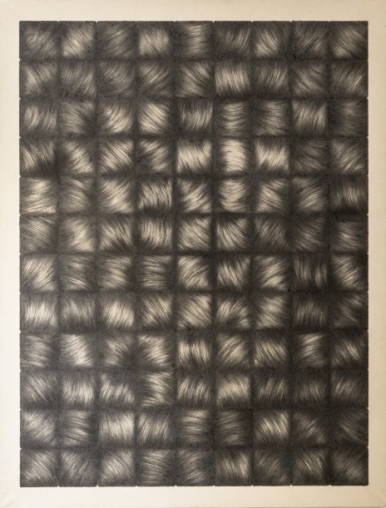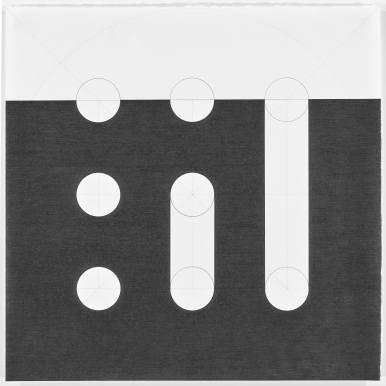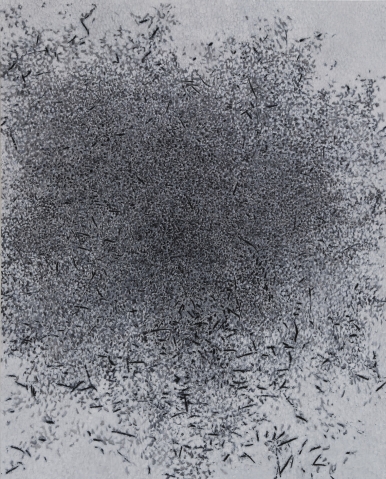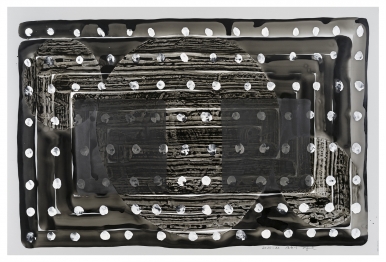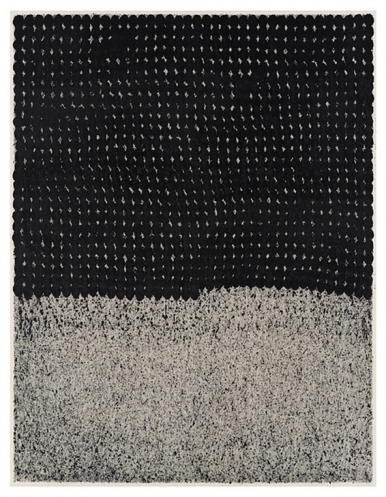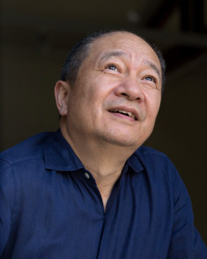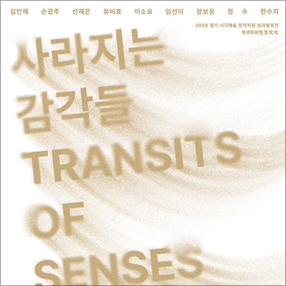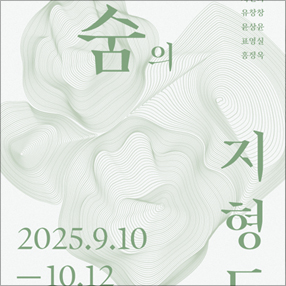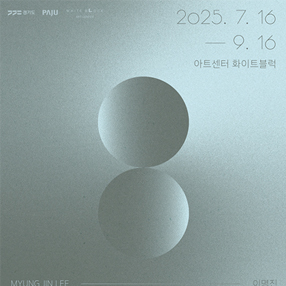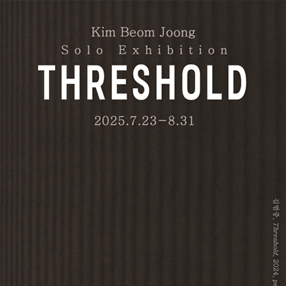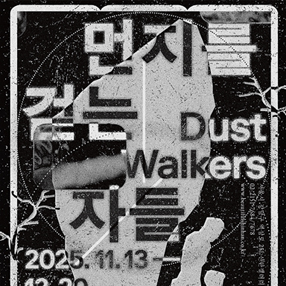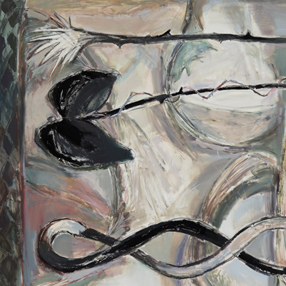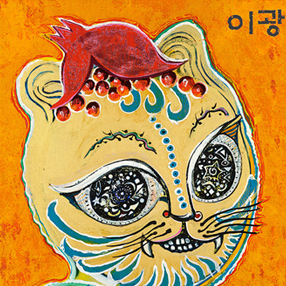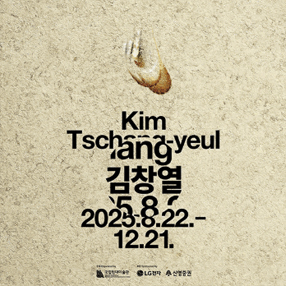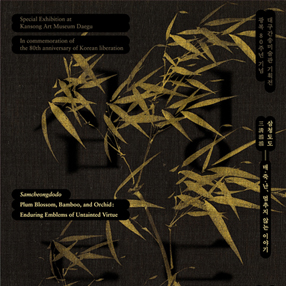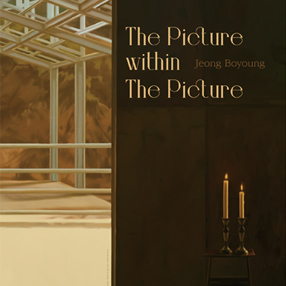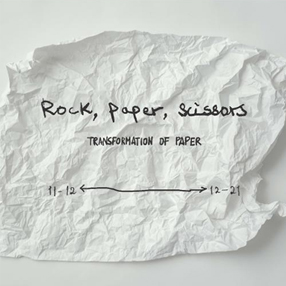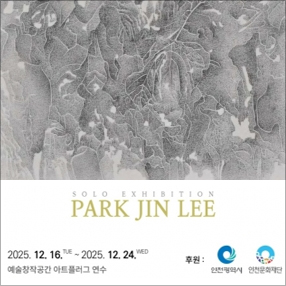본문
-
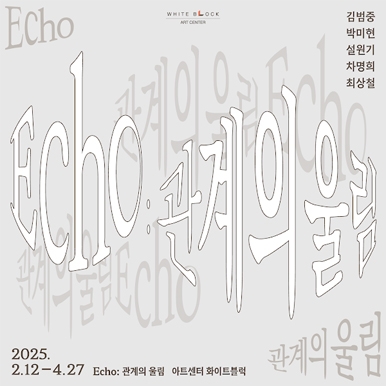
전시 포스터
-
김범중
Sonoration, 2020, pencil on Korean paper, 105x80cm
-
박미현
2-3,, 2022, mechanical pencil on paper, 38×38cm
-
차명희
숲, 2025, mixed media on canvas, 162x130cm
-
설원기
2020-32, 2020, mixed media on mylar, 61x92cm
-
최상철
무물(無物) 21-2, 2021, acrylic on canvas, 162.2x130.3cm
-
Press Release
Echo: 관계의 울림
추상은 더이상 전위적이지 않다. 서구 유력 미술사가들은 추상회화야말로 모더니즘 기획의 전부였다고 입을 모은다. 모더니즘을 주도한 매체가 회화였고 그 절정을 누린 것이 추상회화라고 못박으며 추상회화의 위치를 지정하였다. 1980년대에 도달하자 추상회화가 빈사 상태라는 선언으로 반전되었는데 이는 사실 주류 남성 추상작가들의 작업에 한정된 측면이 크다. 여전히 여성 (추상)작가들에 대한 연구는 빈약한 실정이며 주류 미술사가 고착시켜 놓은 추상미술작가 군단을 재검토하고 회화에 대한 다각적 논의를 새로이 할 때다. 이 같은 인식 아래 아트센터 화이트블럭은 김범중, 박미현, 설원기, 차명희, 최상철의 5인전 《Echo: 관계의 울림》을 개최한다. 작가들이 왕성하게 활동한 시기의 작품들 중에서 작업의 면모를 파악할 수 있는 대표작들로 엄선하였고, 최근작까지 포함하여 작업의 변화 양상을 살필 수 있게 하였다. 이들은 미술 현장에서 무채색의 드로잉을 기반으로 하는 작업을 꾸준히 이어오며 집단적 활동 뿐만 아니라 독자적 모색을 추구해 왔지만 현재까지 이들의 화업을 비평적 관점에서 면밀히 분석한 연구는 손에 꼽을 정도이다. 본 전시를 통해 이들의 역사를 과거로 흘려보내는 것이 아니라 현재에 재위치시키고 작품에 대한 다시 읽기를 시도한다.
김범중(b.1970~)은 장지(Korean paper)위에 날카롭고 뾰족한 연필을 새기듯 눌러가며 수많은 선을 만들어낸다. 일정의 간격을 유지하면서도 극도로 섬세하게 그어진 선들을 가까이서 살펴보면 굵기와 밝기, 질감의 차이를 보이면서 무한에 가깝게 펼쳐진다. 이 선들은 그리드와 소용돌이의 수직과 나선으로 확장되어 일정한 군집을 형성하는데 이 지점에서 김범중의 작업은 기하추상(Geometric Abstraction)의 엄정한 형식주의를 떠올리게 한다. 하지만 서구 기하추상의 주축을 이루던 수직과 수평의 그리드 구조의 폐쇄성을 걷어내고 좀 더 유연한 공간감을 보여준다는 측면에서 일종의 공간 연구로 볼 수 있다. 연필만으로 구현되는 그의 화면은 회화의 평면성이나 환원성에 갇혀 있던 수직과 수평의 구조를 이완시키고 그 구조를 느슨하게 만들고 마침내 해체시키는, 회화적이면서도 탈회화적인 방법론에 수렴한다. 이는 구조가 서로 연결되거나 얽혀있는 리좀(rhizome)을 연상시킨다. 화면 속 단위와 단위가 분할된 구조 내에서 또 다른 형태가 계속해서 생성되고 하나의 고정된 형태가 아닌 다른 구조를 통해 본래의 구조가 더욱 존재감을 가지면서 유연한 공간을 지속해서 등장시키는 것이다. 동양적인 재료로 서구의 형식을 이탈하려는 양가적 미적 태도에서 비롯된 김범중의 작업은 동서양을 아우르면서 그 양쪽의 이면을 드러내고 동시에 해체하려는 점에서 그를 흥미로운 동시대 예술가로 자리매김하게 한다.
박미현(b.1972~)은 종이 위에 샤프펜슬을 사용한 드로잉 작업을 통해 지지대와 매체의 물성을 탐색하는 작업을 보여준다. 사물의 근원에 대한 탐구를 작업의 일관된 동력이자 작업 전반을 관통하는 주제로 삼고 있는 박미현에게 점을 하나씩 찍어 나가는 것, 선을 한 줄씩 그어가는 것은 흐르는 시간 속에서 살아있음을 감각하는 일이자, 점과 선이 구현하는 시각적 결과물을 좇으며 생동이 지닌 가능성을 탐구하는 것에 다름아니다. 우리가 일상에서 흔히 사용하는 소위 ‘샤프’를 주요한 매체로 채택한 그의 드로잉은 작업에 사용하는 재료의 물성을 탐구하는 일이 작업의 동력 혹은 목적이 될 수 있다는 지점에서도 흥미롭다. 주 재료는 종이(수채화지)와 흑연(샤프펜슬)으로 종이가 흑연을 어느 정도까지 손상없이 받아낼 수 있는가를 실험하듯 탐구하듯 이어 간다. 때로는 아교나 픽사티브같은 중간정착액을 사용하기도 하지만 가급적 이를 최소화하여 재료 간 충돌과 조화를 살피는데 이번 전시의 출품작에서는 검은색을 가장 효과적으로 드러내는 수채화지를 주 재료로 한다. 연필보다 한층 섬세하고 세밀한 샤프펜슬을 사용하는 것도 같은 맥락으로, 종이 위에서 흑연으로 구현할 수 있는 드로잉의 가능성과 한계를 두루 아우른다. 종이 한 장, 한 장의 화면 안에 들어찬 원(점)들은 각자의 배열과 구성, 흐름을 지닌 채 나머지 연작과 이웃하며 예기치 못한 리듬과 운율을 이루며 확장된다.
설원기(b.1951~)는 구상과 추상, 회화와 드로잉의 경계를 넘나들며 시각언어의 진화 과정에 대한 고민과 연구를 거듭하고 있다. 나무판이나 린넨에 유화를 그리거나, 마일라(Mylar)라고 하는 유백색 반투명의 강화 폴리에스터 필름 위에 연필, 잉크, 목탄가루, 아크릴, 과슈 등 다양한 재료들을 사용하여 조형의 기본요소인 점, 선, 면 그리고 색채를 표현한다. 플라스틱 종이라고 할 수 있는 마일라는 캔버스와는 달리 물감 흡수률이 적기 때문에 보다 맑고 투명하게 느껴지고 즉흥적인 붓터치가 그대로 남는다. 때문에 근접했을 때는 모호했던 이미지들이 조금 물러나서 볼 때 형태를 이루게되면서 오히려 대상을 한 눈에 파악하게 하는 효과가 있어 작가가 자주 사용하는 재료이다. 이전 작업에서는 풍경이나 기억 같은 삶의 편린을 담아내었지만 본 전시에서는 연도를 암시하는 숫자로 이루어진 추상적인 제목, 선과 점, 면이 구성하는 드로잉과 회화적 제스처 사이 지시대상과 조형적 언어의 거리가 먼 작품들로 채워진다. 선의 본래적 속성, 선으로 만들어내는 면과 같은 조형의 기본 요소들의 특성이 유지되어 균형을 이루면서도 한 켠에서는 번지거나 얼룩진 듯 불협화음적인 요소가 동시에 나타나는 것이다. 그림 속에서 내러티브를 최대한 배제하고 리듬, 속도, 흐름에 자신을 맡겨 더 즉흥적이고, 단순하고 솔직한 느낌이 자연스럽게 드러나는 경지에 이르고 싶다는 작가의 말과 연결되는 지점이다.
추상화와 사실적 회화의 경계에서 직감적이고 즉흥적인 작업을 이어온 차명희(b.1947~)는 동양화로부터 비롯된 문인화의 정신을 현대적으로 계승하면서도 동양화의 재료가 지닌 한계를 벗어나 종이, 한지 뿐만 아니라 캔버스, 아크릴, 목탄 등 새로운 재료 탐색을 통해 자신만의 양식을 개척해 왔다. 빨리 마르고 성질이 다양한 마티에르(Matière)를 표현할 수 있다는 점이 두드러지는 아크릴의 특성을 활용하여 바탕에 칠해진 색이 마르기 전에 화면을 긁어서 그 자국을 남게 하여 자유로운 화면을 구사한다. 차명희가 본격적으로 작업활동에 매진하기 시작한 1980년대 한국미술은 재료에 대한 다양한 실험이 이루어지고 표현의 자유에 대한 갈망이 커지면서 현대 한국화가 다면화되고 심화되었던 시기이다. 특히 여성 작가들에게 척박한 환경과 조건 속에서도 차명희는 나름의 실험과 도전을 지속하면서 40여 년의 시간에 걸쳐 흑백의 추상적 화면 위 단순화된 선과 면의 조화를 통해 독자적인 화풍을 일구어왔다. 이번 전시작의 주를 이루는 목탄을 이용한 작업은 캔버스에 젯소를 칠하고 재료가 마르기 전 제한된 시간 속에서 즉흥적으로 목탄을 올린 것이다. 정확한 타이밍과 정교함, 극도의 인내심이 요구되는 작업이다. 무채색의 화면과 기교 없이 단순한 검은색 선이 이루는 그의 작업은 서양화의 재료와 동양적 미감의 조화 속에 편안한 여백과 열린 공간에 대한 경험으로 이끈다. 이는 자연스럽게 작품에 대한 관조로 이어져 작가가 오랜 시간 화면 안에 담아온 감정과 정서에 가 닿는다.
최상철(b.1946~)은 1960년대와 70년대의 앵포르멜(Informel) 열기 속에서 현대회화의 가능성과 의미에 대한 새로운 해석과 탈출구를 찾고자 하였다. 또한 기하학적 추상미술 운동의 성과를 계승하면서도 비회화적 한계와 논리 속으로만 함몰되는 과정을 극복하고자 했다. 가장 순수한 형태를 탐구하며 인간 감정의 흔적을 없앤 기계적이고 기하학적인 색면, 그리고 원색의 대비가 강조된 화면을 통해 캔버스 밖으로까지 확장되는 구조적인 힘과 이를 통해 분출되는 강한 에너지를 나타내었다. 80년대에 이르러 순수한 기본 형태로 구성된 조형과 단색조의 색감으로 대상을 단순화시킴으로써 서구 미니멀리즘의 형식주의와 구별되는 한국 단색주의 회화의 초기 흐름을 보여준 바 있다. 이번 전시의 <무물(無物)> 연작은 「노자」에 등장하는 ‘사물이 태어나기 이전의 혼돈된 상태’에서 빌려온 개념으로 일체의 형상과 의도를 덜어낸 순수한 표현과 그 흔적만으로 이루어진 작품이다. 2004년 이후 지속된 <무물> 시리즈는 모든 색을 제거하여 오직 검은색만이 남겨졌다. 붓을 사용하지 않고 물감이 묻은 돌이나 쇠막대기를 캔버스 위에서 반복하여 굴리는 행위를 통해 얻어진, 추상도 구상도 자연도 세속도 아닌 어떤 세계. 그 반복은 한자로 횟수를 적어가며 천 번을 목표로 하여 지속된다. 최종적인 이미지는 무의미해지고 그 지난한 여정 자체에 방점이 찍힌다. 이것은 과정의 문제로 전환되며 불확실한 결과마저 예술의 일부로 받아들이게끔 하는 것이다.
‘무채색 드로잉’이라는 큰 범주에 있지만 고유의 특색을 보여주는 다섯 작가의 작품은 모두 고유의 파장을 가지고 있다. 하나의 울림이 타인에게 전달되고 그 울림이 다시 반향되는 순간, 각자의 세계가 이어지고 다른 이야기로 연결된다. 본 전시 《Echo: 관계의 울림》을 매개로 5인 작가의 드로잉과 회화가 모여 더 큰 이야기, 더 넓은 울림을 전달하고 그 울림과 진동, 파장이 전시장 안에서 무심한 듯 오고 가면서 다시 누군가에게 전달되어 새로이 발견되기를 바란다.
원채윤 | 아트센터 화이트블럭 학예팀장
Echo: Resonance of Relations
Abstract art is no longer considered avant-garde. Prominent Western art historians collectively assert that abstract painting was the essence of the modernist project. They firmly establish its position by emphasizing that painting was the medium that spearheaded modernism and that abstract painting marked its apex. By the 1980s, this was reversed with the declaration that abstract painting was dead, which was largely limited to the paintings of mainstream male abstract artists. Research on female abstract artists remains limited, underscoring the importance of revisiting the group of abstract artists defined by mainstream art history and fostering a more nuanced and inclusive discussion on painting. With this perspective in mind, Art Center White Block presents the group exhibition Echo: Resonance of Relations, featuring five artists—Kim BeomJoong, Park MiHyun, Sul WonGi, Cha MyungHi, and Choi SangChul. The exhibition presents a carefully curated selection of representative works from the periods when the artists were most active, allowing for an in-depth understanding of their practices. It also includes recent pieces, offering a glimpse into the evolution of their artistic trajectories. These artists have consistently worked with monochromatic drawing, pursuing both collective activities and independent explorations. However, critical analyses of their artistic careers remain scarce. This exhibition seeks to reposition their history in the present rather than consign it to the past, offering a fresh interpretation of their works.
Kim BeomJoong(b.1970~) creates countless lines by pressing a sharp, pointed pencil onto Korean paper (jangji). While maintaining consistent spacing, the meticulously drawn lines reveal subtle variations in thickness, brightness, and texture upon close examination, unfolding in an almost infinite expanse. These lines expand into vertical and spiral formations of grids and vortices, forming organized clusters. At this point, Kim’s work evokes the rigorous formalism of geometric abstraction. However, unlike the rigid, closed grid structures central to Western geometric abstraction, his work removes this sense of confinement, presenting a more fluid spatiality. In this sense, it can be seen as a form of spatial exploration. His pencil-rendered surfaces loosen and ultimately dismantle the rigid vertical and horizontal structures that once confined painting to flatness and reductionism. This approach, both painterly and post-painterly, dissolves traditional frameworks, converging into a methodology that recalls the interconnected and intertwined nature of a rhizome. Within the divided structures of the composition, new forms continuously emerge. Rather than settling into a fixed shape, the original structure gains greater presence through these evolving configurations, consistently introducing a dynamic and flexible sense of space. Kim BeomJoong’s work, stemming from an ambivalent aesthetic approach that seeks to diverge from Western forms while employing Eastern materials, bridges Eastern and Western traditions. He establishes himself as a compelling contemporary artist by simultaneously revealing and deconstructing the underlying aspects of both.
Park MiHyun(b.1972~) explores the materiality of supports and mediums through her meticulous pencil drawings on paper. Her work is driven by a consistent inquiry into the essence of objects, a theme that permeates her entire artistic practice. For Park, the act of placing dots one by one and drawing lines stroke by stroke is a means of sensing her existence within the flow of time. At the same time, it is an exploration of the potential for vitality, pursued through the visual outcomes manifested by these dots and lines. Her choice of the everyday “mechanical pencil” as a primary medium lends a compelling dimension to her drawings, highlighting how the exploration of a material’s physical properties can serve as both the impetus and the objective of her practice. Using watercolor paper and graphite (mechanical pencil) as her main materials, she engages in a process akin to experimentation, testing the limits of the paper’s capacity to withstand and accommodate graphite without incurring damage. Occasionally employing intermediary fixatives such as hide glue or fixative sprays, she strives to minimize their use, focusing instead on examining the interplay and harmony between materials. For the works featured in this exhibition, she has chosen watercolor paper as the primary medium, selected for its ability to most effectively accentuate the depth of black. Her use of the mechanical pencil—a tool even more delicate and precise than a traditional pencil—further reflects her intention to explore the full spectrum of possibilities and limitations of graphite-based drawing on paper. The circles (dots) densely filling each sheet of paper possess their own unique arrangements, compositions, and flows. Coexisting with neighboring works within the series, they collectively generate an unexpected rhythm and cadence, expanding into a dynamic and resonant visual progression.
Sul WonGi(b.1951~) is deeply engaged in exploring and researching the evolutionary process of visual language, transcending the boundaries between representation and abstraction, as well as between painting and drawing. His work involves creating oil paintings on wooden panels or linen and utilizing a variety of materials such as pencil, ink, charcoal powder, acrylic, and gouache on a semi-translucent, milky-white Mylar, a reinforced polyester film. Through these mediums, he expresses the fundamental elements of form—dots, lines, planes, and colors. Mylar, often referred to as a type of plastic paper, differs from canvas in its low paint absorption rate, resulting in a clearer and more transparent appearance. The spontaneous brushstrokes remain vividly intact, creating an intriguing effect: images that appear ambiguous up close come together to form recognizable shapes when viewed from a distance, allowing viewers to grasp the subject at a glance. This unique quality makes Mylar a frequently used material in his work. In previous works, fragments of life such as landscapes or memories were captured, but this exhibition is filled with works that feature abstract titles comprised of numbers hinting at specific years and drawings or painterly gestures composed of lines, dots, and planes. These pieces exhibit a significant distance between their referential subjects and the visual language they employ. The inherent properties of lines and the fundamental characteristics of compositional elements like planes created from lines are maintained in harmony, while certain areas simultaneously display discordant features, resembling smudges or stains. This aligns with his aspiration to exclude narrative as much as possible, instead surrendering to rhythm, speed, and flow, ultimately achieving a level where a more spontaneous, simple, and honest essence naturally emerges.
Cha MyungHi (b. 1947~), who has continued an intuitive and spontaneous approach at the boundary between abstraction and figurative painting, has modernized the spirit of traditional Korean literati painting while transcending the material limitations of traditional East Asian painting. Beyond paper and Korean traditional paper of hanji, she has explored new mediums such as canvas, acrylic, and charcoal, carving out a unique style that reflects her artistic evolution. She takes advantage of the distinctive properties of acrylic, which dries quickly and allows for a diverse expression of texture (Matière). By scratching the surface before the applied paint dries, she leaves intentional marks, creating a dynamic and liberated composition on the canvas. She began dedicating herself to her artistic practice in the 1980s, a period in Korean art marked by diverse experimentation with materials and a growing yearning for freedom of expression. During this time, contemporary Korean painting underwent significant diversification and deepening. Despite the challenging circumstances and limited opportunities faced by women artists, she persisted in her experiments and challenges, cultivating a unique artistic style over four decades. Her work is characterized by the harmony of simplified lines and planes within abstract black-and-white compositions, establishing her distinct style in the art world. The works featured in this exhibition, predominantly created with charcoal, involve applying gesso to canvas and then expressing ideas spontaneously with charcoal before the material dries. This process demands precise timing, meticulous skill, and exceptional patience. Her compositions, marked by monochromatic surfaces and simple black lines devoid of embellishment, harmonize the materials of Western painting with an Eastern aesthetic sensibility. The result invites the audience into an experience of tranquil emptiness and open space, naturally leading to a contemplative engagement with the artwork. Through this, the audience connects with the emotions and sentiments that she has imbued in her canvases over time.
Choi SangChul(b.1946~), amidst the fervor of the Informel movement in the 1960s and 1970s, sought to explore new interpretations and avenues for the possibilities and meaning of contemporary painting. He also aimed to overcome the process of becoming confined within the limitations and logic of non-painterly approaches, while building upon the achievements of the geometric abstract art movement. Through his exploration of the purest forms, he emphasized mechanical and geometric compositions that eliminated traces of human emotion, focusing on contrasts of primary colors and color fields. These works exude a structural force that extends beyond the canvas, radiating a powerful energy. By the 1980s, he demonstrated the early tendencies of Korean Dansaekhwa (monochromatic painting) by simplifying subjects through compositions based on pure, fundamental forms and monochromatic color palettes. This approach distinguished itself from the formalism of Western minimalism, emphasizing a uniquely Korean sensibility rooted in materiality, process, and a meditative aesthetic. The Nothingness series featured in this exhibition draws its concept from the notion of a “chaotic state before the birth of all things” found in Laozi’s teachings. These works are composed solely of pure expressions and traces, stripped of all forms and intentions, embodying an essence that resonates with the fundamental principles of simplicity and unadulterated creativity. Since 2004, the Nothingness series has been characterized by the removal of all colors, leaving only black. Instead of using brushes, he uses tools such as paint-covered stones or metal rods, repeatedly rolling them across the canvas. This process creates a world that is neither abstract nor figurative, neither natural nor worldly. The repetitive action, guided by the goal of completing one thousand iterations—marked in Chinese characters to count the repetitions—reflects a meditative discipline and an exploration of the boundary between intention and chance. The final image becomes devoid of meaning, shifting the focus entirely to the arduous journey itself. This transformation emphasizes the process, inviting the audience to accept even the uncertain outcome as an integral part of the art.
Falling under the broad category of “monochromatic drawing,” the works of these five artists each possess a distinctive character, resonating with their own unique vibrations. The moment a single resonance is conveyed to another and echoed back, individual worlds intertwine, forming connections that lead to entirely new stories. This exhibition titled Echo: Resonance of Relations, brings together the drawings and paintings of five artists, weaving them into a larger narrative and a broader resonance. It is our hope that the echoes, vibrations, and waves generated within the exhibition space will subtly flow back and forth, eventually reaching someone anew and sparking fresh discoveries.
Chaeyoon Won│Chief Curator of Art Center White Block전시제목Echo: 관계의 울림
전시기간2025.02.12(수) - 2025.04.27(일)
참여작가 김범중, 박미현, 설원기, 차명희, 최상철
관람시간11:00am - 06:00pm
주말, 공휴일: 11:00am - 06:30pm휴관일없음
장르회화
관람료3,000원 (카페 이용 시 관람 무료)
장소아트센터 화이트블럭 Art Center White Block (경기 파주시 탄현면 헤이리마을길 72 (법흥리) )
주최아트센터 화이트블럭
주관아트센터 화이트블럭
연락처031-992-4400
-
Artists in This Show
-
1951년 서울출생
아트센터 화이트블럭(Art Center White Block) Shows on Mu:umView All
Current Shows
-
먼지를 걷는 자들 Dust Walkers
신한갤러리
2025.11.13 ~ 2025.12.20
-
유리: 투명한 고리
갤러리 학고재
2025.11.19 ~ 2025.12.20
-
이광 개인전 《우주호랑이- 호랑이 여자로 산다는 것은》
갤러리 마리
2025.11.21 ~ 2025.12.20
-
김창열
국립현대미술관
2025.08.22 ~ 2025.12.21
-
삼청도도 三淸滔滔 – 매·죽·난, 멈추지 않는 이야기
대구간송미술관
2025.09.23 ~ 2025.12.21
-
정보영: 그림 속의 그림: The Picture within The Picture
성남큐브미술관
2025.10.24 ~ 2025.12.21
-
Rock, Paper, Scissors: Transformation of Paper
갤러리현대
2025.11.12 ~ 2025.12.21
-
박진이: 『숨』 – 날·갯·짓
아트플러그 연수
2025.12.16 ~ 2025.12.24




